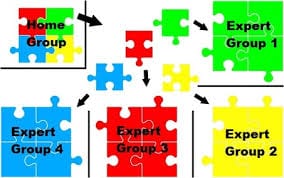Student Contributor: S. Shier
 Jigsaw grouping is a great strategy to group your students when learning a subject where there are multiple aspects to cover. It can be helpful as they can put together the puzzle that their jigsaw pieces create to already begin coming together as a group before they even start the task they were given.
Jigsaw grouping is a great strategy to group your students when learning a subject where there are multiple aspects to cover. It can be helpful as they can put together the puzzle that their jigsaw pieces create to already begin coming together as a group before they even start the task they were given.
This tool can be used efficiently when there are multiple aspects of a topic that need to be covered at once such as the parts of a human cell. You can put numbers on the back of the puzzle piece to give you multiple types of grouping. This allows for expert grouping as well. You can use the numbers on the back of the puzzle piece to give each numbered group a specific part of the cell to study. These are your “expert groups” as they will become the expert on that part of the cell when they are merged into their jigsaw group. The students will then switch groups to find the students who have pieces from the same puzzle and will share what they learned from their first group with this second group. What I love about this type of grouping is that when students move to that second jigsaw group, it allows for initial team building by first completing that puzzle they are given before they even start sharing their findings with the group. I have had experience with this type of grouping in a class with Gus Nollmeyer and I found it to greatly benefit the way I learned the topic at hand.
 I placed this tool in the supportive phase of management because it supports students working together and building that community or team in the classroom. This connects to the preventative phase by building a close community within your students and the classroom as a whole allows for less conflict and a sense of unity. This would help support your students to stray from needing to be in the corrective phase as they would self-manage while in these groups. I connected this tool with the student directed and collaborative theories of influence as students must be willing to work collaboratively with their peers to be able to successfully use this grouping strategy. The teacher must also trust that their students can manage themselves in their groups when it comes time to work with their peers and even in the transition between the two groups.
I placed this tool in the supportive phase of management because it supports students working together and building that community or team in the classroom. This connects to the preventative phase by building a close community within your students and the classroom as a whole allows for less conflict and a sense of unity. This would help support your students to stray from needing to be in the corrective phase as they would self-manage while in these groups. I connected this tool with the student directed and collaborative theories of influence as students must be willing to work collaboratively with their peers to be able to successfully use this grouping strategy. The teacher must also trust that their students can manage themselves in their groups when it comes time to work with their peers and even in the transition between the two groups.
More Information –
Tool Source: Gus Nollmeyer
https://www.teachervision.com/jigsaw-groups-cooperative-learning

